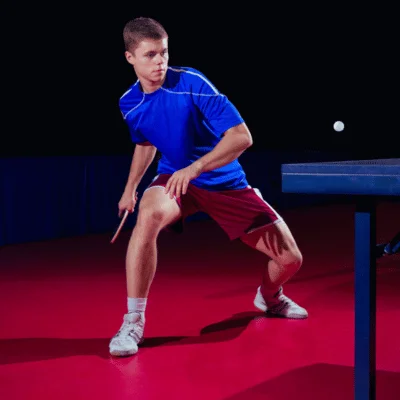In Table Tennis, there are four fundamental strokes – Forehand Drive, Forehand Push, Backhand Drive, and Backhand Push.
The Forehand Push involves a controlled, low-speed shot,
while the Backhand Drive requires power and accuracy,
and the Backhand Push is a defensive stroke used to return low-speed shots with control.
Exploring the Range of Strokes in Table Tennis
Forehand Drive:
The forehand drive is one of the fundamental strokes in table tennis, characterized by its power and speed. Players execute this stroke by making contact with the ball on the forehand side of their body and using a forward motion to drive the ball across the table with force. Proper footwork and body positioning are crucial for generating maximum power and accuracy.
Backhand Drive:
Similar to the forehand drive, the backhand drive involves striking the ball on the backhand side of the body. Players use a combination of wrist and arm movement to generate speed and control, directing the ball with precision across the table. Developing consistency and timing is key to mastering the backhand drive.
Forehand Topspin Loop:
The forehand topspin loop is a dynamic and aggressive stroke commonly used to put pressure on opponents. Players impart topspin on the ball by brushing the racket upward and forward, causing the ball to dip sharply over the net and bounce with increased spin on the opponent’s side. This stroke requires excellent timing and racket speed to execute effectively.
Backhand Flick:
The backhand flick, also known as the backhand flip, is a quick and compact stroke used to attack short balls with speed and precision. Players execute this stroke by making contact with the ball close to the body and using a flicking motion to propel the ball over the net with minimal backswing. The backhand flick is particularly effective against serves and short returns.
Backhand Chop:
The chop is a defensive stroke employed to return heavy topspin shots from opponents. Players execute this stroke by striking the ball with a downward chopping motion, imparting backspin to counteract the opponent’s topspin. The chop is often used to control the pace of the game and force opponents into making errors.
Backhand Block:
A quick, controlled shot used to deflect the opponent’s shot with minimal motion.
Counterhit:
The counterhit is a reactive stroke used to return fast-paced shots with speed and control. Players execute this stroke by making contact with the ball at the peak of its bounce and using a short, punching motion to redirect the ball back across the table. Timing and anticipation are crucial for effectively countering opponents’ shots.
Check out the following links for more in-depth guidance and strategies:
How to Hold a Ping Pong Paddle Chinese Style
20 Ping Pong Tips and Techniques for Beginners and Experienced Players
Different Styles of Play in Table Tennis: Offensive vs. Defensive
Three Offensive Strokes in Table Tennis
Offensive Strokes:
- Hit (Speed Drive)
- Loop
- Counter-hit
Three Defensive Strokes in Table Tennis
Defensive Strokes:
- Push
- Chop
- Block
Summary
Frequently Asked Questions (FAQs) About Table Tennis Strokes
What are the different types of strokes in table tennis?
Table tennis strokes vary depending on whether they are offensive or defensive. Offensive strokes include hits, loops, and counter-hits, while defensive strokes include pushes, chops, and blocks.
How can I improve my table tennis strokes?
Improving your table tennis strokes requires practice, technique, and consistency. Focus on mastering the proper form and mechanics of each stroke through drills and repetition. Additionally, receiving feedback from a coach or experienced player can help identify areas for improvement.
What is the difference between a forehand and a backhand stroke?
In table tennis, a forehand stroke is executed with the racket on the dominant hand’s side of the body, while a backhand stroke is executed with the racket on the non-dominant hand’s side. The mechanics and techniques for each stroke vary, and players often develop strengths in one or both sides.
How can I generate more power in my table tennis strokes?
Generating power in table tennis strokes requires proper technique and timing. Focus on using your entire body to generate force, including your legs, hips, and torso. Additionally, using a fast racket and making contact with the ball at the correct timing can increase the power of your strokes.
What are some common mistakes to avoid when executing table tennis strokes?
Common mistakes in table tennis strokes include improper grip, incorrect body positioning, and lack of follow-through. To avoid these mistakes, focus on maintaining a relaxed grip, staying balanced and mobile, and completing the stroke with a full extension of your arm and wrist.
Are there different variations of table tennis strokes for specific playing styles?
Yes, players often develop variations of table tennis strokes based on their playing style and preferences. For example, some players may emphasize spin in their strokes, while others may focus on speed and power. Experimenting with different techniques and adapting them to your playing style can help improve your overall performance.



